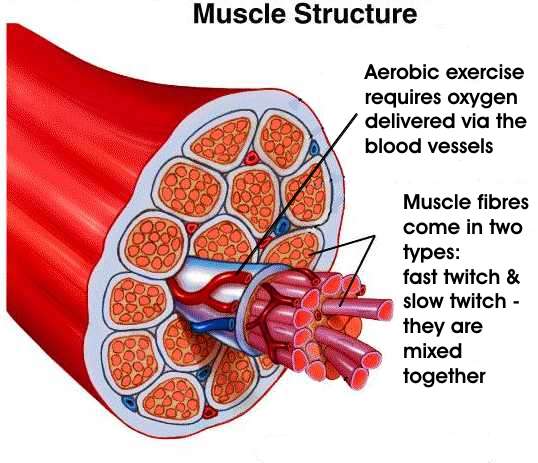If you want to build muscle as fast as possible you need to do muscle fiber specific training! – Nope, you don’t.
We all want to build more muscle as fast as possible, but muscle fiber specific training is definitely not the way to do it.
Before we dive a little deeper into the topic, let’s have a look what muscle fibers are and how they are built.

Structure of the muscle fibers
Every muscle of the musculoskeletal system consists of muscle fibers. Several muscle fibers are grouped into muscle fiber bundles, several muscle fiber bundles together make up the muscle.
The muscle fiber is also the muscle cell. Muscle fibers, however, differ from typical cells: they are much larger in scale.
The longest muscle fibers in the human body can reach 30 – 40 cm in length. Nor can they proliferate by cell division, as is common in most cell types.
Muscle growth instead takes place (mainly) through growth in thickness, not by cell division.
Meaning, your muscle fibers grow in size, they don’t multiply.
In the human body, we differentiate between two types of muscle fibers.
Muscle fiber types are highly specialized. The body is adapted to the different pressures that affect us in everyday life and in sports.

Muscle fiber Type 1 and Type 2
Type 1 muscle fibers
Type 1 muscle fibers are designed for continuous performance with limited force. They are very fatigue-resistant but have a comparatively low level of strength. You can, therefore, call them endurance muscle fibers or Slow-Twitch muscle fibers.
Construction
Slow-Twitch muscle fibers contain many mitochondria, which operate as cell power plants for oxidative metabolism.
In contrast, the number of myofibrils is lower than in type 2 muscle fibers. As a result, Type 1 muscle fibers are inherently smaller in diameter.
Metabolism
The endurance muscle fibers are the more economical of both muscle fiber types. They are mainly specialized in oxidative metabolism (use of oxygen).
As a result, they are able to fully utilize the body’s existing energy resources. There are no waste products that tire the muscle.
However, this metabolic pathway is slower. As a result, the Type 1 muscle fibers are unable to deliver large amounts of energy at once.
Due to their slower metabolism and the type of nerve impulses, the type 1 muscle fibers not only develop less force but also have a lower contraction rate.
They are therefore also called slow-twitch muscle fibers.
The body always tries to keep its resources as economically as possible. Therefore, only endurance muscle fibers are used for everyday stress and moderate exertion.
Only with larger exertion or explosive movements, additional muscle fibers of type 2 are recruited – but only as many as necessary.
Appearance
Type 1 muscle fibers contain a lot of the red muscle pigment myoglobin (responsible for the oxygen transport within the muscle cell). Therefore, they are also referred to as red muscle fibers.
As you can see, the researchers were very creative in giving as many different names to the same muscle fiber types as possible.
Just remember the terms type 1 muscle fiber and endurance muscle fiber.
Type 2 muscle fibers
Type 2 muscle fibers tire quickly but are able to develop enormous power. They are also called fast-twitch muscle fibers.
Because of rapid fatigue, muscle fibers are not designed for continuous operation. They are used by the body to support the Type 1 muscle fibers during heavy exertion or explosive movement. High efforts can only be sustained for a short time.
Construction
According to their function, the interior of the muscular-muscle fibers consists predominantly of so-called myofibrils.
These are contractile protein structures that extend from one end of the muscle fiber to the other and do the actual muscle work.
Metabolism
The type 2 muscle fibers are optimized for antioxidative metabolism (combustion without oxygen).
This gives them access to metabolic pathways that can quickly provide a great amount of energy for intense muscle contractions.
The disadvantage is that carbohydrates cannot be completely degraded via the antioxidative (or anaerobic) system.
The waste product lactate remains. Lactate also gives you that burning to feel after a hard set.
If a critical lactate concentration is reached in the muscle, no further contraction is possible. Muscle failure occurs.
The anaerobic metabolic pathways also include ATP and creatine energy (the latter is probably already known to you as a nutritional supplement). If you want to know more about creatine, check our article.
The type 2 muscle fibers have particularly large phosphate stores (storage for ATP and creatine). There is no lactate.
However, phosphate stores only provide energy for a few seconds.
Because of the fast metabolic pathways and the rapid innervation, the type 2 muscle fibers have a high force level as well as a high contraction speed.
They are therefore also known as Fast Twitch Muscle Fibers.
Appearance
The muscle fibers have little red muscle dye (myoglobin) because they are less dependent on oxygen transport.
The lack of myoglobin gives them a pale color, which also earned them the name White Muscle Fibers.

Muscle fiber types and muscle growth
Strength training in muscle has many adaptations.
The visible muscle growth is caused by myofibrils (contractile protein structures) multiplying in the muscle fiber.
The mechanical load during strength training causes damage to the myofibrils.
This triggers complicated repair processes that ultimately increase the number of myofibrils in the muscle fiber.
As a result, the muscle fiber grows and your muscle looks bigger. Yay!
Muscle growth in type 1 muscle fibers
Unfortunately, the endurance muscle fibers contain relatively few contractile protein structures. In addition, they do not develop high muscle tension.
As a result, they are less susceptible to mechanical stress stimuli.
Type 1 muscle fibers have low growth potential.
They adapt to strength training, especially on a metabolic level. But that does not mean that endurance muscle fibers can not grow at all.
Through metabolic adjustments, the mitochondria proliferate and the glycogen stores (carbohydrate stores) increase.
This too leads to a certain increase in circumference, a bigger muscle.
Type 1 muscle fibers grow mainly through metabolic stress during training. The most important growth stimulus for them is the training volume and high reps. Weight is of secondary importance.
Muscle growth in type 2 muscle fibers
Fast twitch muscle fibers adapt to weight training primarily by an increase in their contractile protein structures.
They build up high muscle tension during training and experience so-called microtraumas, resulting in growth stimuli.
Type 2 muscle fibers have high growth potential.
Type 2 muscle fibers grow mainly by mechanical stimuli. The most important growth stimulus for them is weight and the resulting muscle tension. The training volume only plays a minor role.
Muscle fiber types and regeneration
The two muscle fiber types have different levels of regeneration.
It takes a long time to repair mechanical damage. Mechanical damage is mainly caused in Type 2 muscle fibers.
Consequently, Type 2 muscle fibers need a longer recovery.
So, where are we?
Type 1 muscle fibers: Grow slowly but regenerate faster
Type 2 muscle fibers: Have high growth potential but regenerate slowly.
Let’s get back to the topic, what does that mean for your workout?
Muscle fiber specific training?
Muscle fiber specific training? Sounds interesting, right?
To get the most out of your workouts you should better tailor it to your individual body needs, to get optimal results?
During everyday activity such as walking, you will mainly use Type 1 muscle fibers.
As soon as these muscle fibers are not strong enough anymore to carry the load, Type 2 muscle fibers are recruited in addition.
At an intensity of around 60% of your 1 rep max., your body starts recruiting Type 2 fibers. At a level of intensity of 85% of the 1 rep max or more, all available muscle fibers are recruited.
As most of you will use at least 60% of their 1 RM during their workouts, your body will recruit both types at the same time anyway. ? When training heavy and with high intensity, you will train both types.
Also, Type 2 muscle fibers are responsible for the majority of muscle growth.
So why make it unnecessary complicated? ? Just focus on results. Heavy but smart training.
What about muscle fiber tests?
Muscle fiber tests are advocated by many athletes.
The reason being is, you find out what your muscle is made of. Mainly Type 1 or mainly Type 2.
If you know that you can adjust your training to your specific body needs, right? Well, no.
First of all, these tests are incredibly unprecise. Secondly, it really doesn’t matter. Either way, you should train exactly the same. Heavy but smart.
If your a looking for a full guide on how to build muscle fast, check out our article!
What are your thoughts on muscle fiber specific training?
Cheers,
Sam





2 thoughts on “Muscle Fiber Specific Training – Truth or Myth?”
Saved as a favorite, I really like your blog!
Maglia Calcio
Thank you lots!